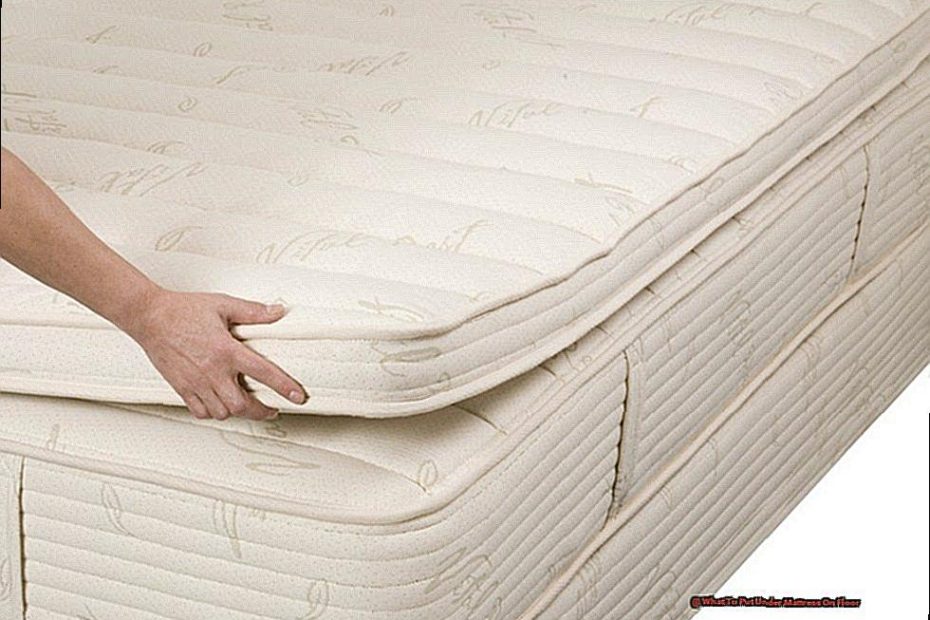Are you ready to break away from the conventional bed frame and embrace a simpler, more minimalistic way of sleeping? Or are you in need of a temporary solution while you save up for a new bed? Whatever your reason may be, sleeping on a mattress on the floor has become a popular trend with its own set of benefits – from improved posture to more space in your room. But before you take the plunge, it’s crucial to consider what lies beneath your mattress to ensure a comfortable and supportive sleep.
In this blog post, we’ll delve into the top options for creating the perfect foundation for your floor-sleeping setup. Say goodbye to squeaky bed frames and hello to an organic and budget-friendly way of resting.
Here’s what we’ll cover:
- The significance of proper support for your mattress
- Various types of foundations that work well on the floor
- Innovative alternatives for those on a tight budget
- Tips for maintaining cleanliness and protecting your mattress
- How to elevate your floor-sleeping experience with added style and comfort.
Contents
Options for What Goes Under a Mattress
When considering what to place under a mattress on the floor, it is important to take into account the type of mattress and desired level of support and comfort. While some may opt for a simple buffer such as plywood, foam, or cardboard to prevent direct contact with the floor, others may prefer more eco-friendly and comfortable options like coconut coir bed rugs or traditional Japanese tatami mats. These natural materials not only provide cushioning and support but also help regulate temperature and are durable for long-term use.
For those concerned about moisture buildup in the room, using a dehumidifier can be an effective solution. Not only does it prevent mold and mildew growth, but it also improves air quality. This option can also be used in conjunction with other options for added benefits.
To ensure proper support for spine health and overall comfort when sleeping on a mattress on the floor, using a mattress foundation, mattress topper, or air mattress is recommended. These options not only improve comfort and support but also protect the mattress from wear and tear. With various options available to suit different needs, it is important to carefully consider which one would be most suitable for the individual.
Ultimately, the decision of what goes under a mattress on the floor will vary based on personal preferences and needs.
How to Choose a Mattress Base
To select the perfect mattress base for your floor bed setup, there are several crucial factors to take into account. These include personal preferences and needs, material, size and height of the bed, and budget.
By considering these aspects, you can find an ideal base that not only provides support and comfort for your mattress but also caters to your specific requirements.
Personal preferences and needs:
When choosing a mattress base, it’s important to consider what type of support your body requires. This will depend on personal preferences, such as whether you prefer a firmer or softer surface. If you have any health issues or physical limitations, it’s crucial to consult with a healthcare professional before making a decision.
Material:
The material of the mattress base plays a significant role in its durability and stability. Common materials include wood, metal, and plastic. Each has its own advantages and disadvantages, so it’s essential to weigh them when making your decision.
For example, wood bases are sturdy but may be difficult to move around, while metal bases are lightweight but may not be as durable as wood.
Size and height:
The size and height of your floor bed should also be taken into consideration when choosing a mattress base. If you have a larger floor space, a king or queen size bed may be suitable, which will require a larger and sturdier base.
On the other hand, if you have limited floor space and prefer a lower bed, a twin or full-size mattress base may suffice.
Budget:
Budget is an important factor to consider when selecting a mattress base. While some bases can be expensive, investing in a high-quality one can extend the life of your mattress and provide better support for your sleep.
It’s also crucial to consider the long-term costs of replacing a cheap base versus investing in a durable one.
By taking these factors into account and conducting thorough research, you can find the perfect mattress base for your floor bed setup that meets your specific needs and preferences.
Why Is It Important to Put Something Under a Mattress?
The importance of placing something underneath a mattress on the floor cannot be overstated. Failure to do so can result in a multitude of issues, including voiding the warranty, excessive moisture buildup, uncomfortable height, limited support options, potential damage to foam mattresses, the need for constant cleaning and ventilation, compatibility problems, and doubts about the reliability of the sleep industry.
It is crucial to carefully evaluate these possible repercussions and select an appropriate base for your mattress in order to guarantee optimal comfort, support, and durability.
When it comes to putting something underneath your mattress on the floor, there are a variety of factors that must be taken into consideration. First and foremost, neglecting this crucial step can have serious consequences. One of the most concerning is that it could potentially void the warranty on your mattress, leaving you without any recourse in case of damage or defects.
Additionally, failing to properly support your mattress can lead to moisture buildup over time. This can create a breeding ground for mold and bacteria, which can be detrimental to both your health and the longevity of your mattress. Not only that, but without proper support, you may find yourself struggling with an uncomfortable height or limited options for achieving the desired level of firmness.
In particular, foam mattresses are at risk for damage if not properly supported. Without a solid base underneath, these types of mattresses may sag or develop uneven spots, leading to discomfort and decreased lifespan. Furthermore, regular cleaning and ventilation may become necessary in order to combat excess moisture and potential mold growth.
It’s also important to consider compatibility when selecting a base for your mattress. Certain types of bases may not be suitable for all types of mattresses, which could result in discomfort or even damage over time.
And in an industry where trust is essential, using a proper base can alleviate any concerns about the reliability and integrity of the sleep industry.
Conclusion
In our fast-paced world, many individuals are seeking ways to simplify and declutter their lives. One popular trend that has emerged is sleeping on a mattress on the floor. Whether you’re breaking away from traditional bed frames or in need of a temporary solution, there are numerous benefits to this minimalist approach – from improved posture to more space in your room.
But before you make the switch, it’s crucial to carefully consider what goes underneath your mattress. In this blog post, we’ve explored the top options for creating a comfortable and supportive foundation for your floor-sleeping setup. From natural materials like coconut coir bed rugs and tatami mats to using a dehumidifier for moisture control, there are various choices available to cater to different needs.
When selecting a mattress base, it’s essential to take into account personal preferences and needs, material, size and height of the bed, and budget. Neglecting this step can have serious consequences such as voiding the warranty on your mattress or creating an uncomfortable sleeping experience.
In conclusion, whether you’re looking for an organic and budget-friendly way of resting or simply want to elevate your floor-sleeping experience with added style and comfort, it’s crucial to carefully consider what lies beneath your mattress.
With the right support and foundation in place, you can enjoy all the perks of sleeping on a mattress on the floor without any drawbacks.





